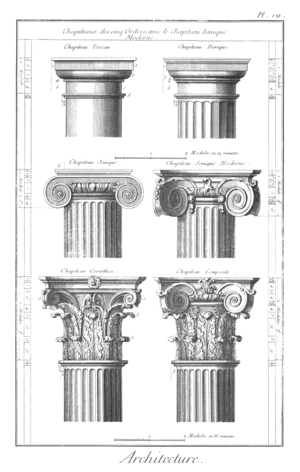The three major classical orders are Doric Ionic and Corinthian. The bases of the columns are also decorated.
As shown in Figure 2 columns are placed close together and are often without bases.

Doric ionic corinthian columns. The Corinthian order was most preferred by the Ancient Romans in their architecture. The Corinthian order is the most ornate of the Greek orders characterized by a slender fluted column having an ornate capital decorated with two rows of acanthus leaves and four scrolls. Their shafts are sculpted with concave curves called flutes.
Ionic column is more slender and more ornate than the earlier Doric style. All these three orders had three separate parts of the base shaft and the capital. The shaft the tall part of the column is plain and has 20 sides.
Lastly Corinthian columns were introduced. Ionic Column The Ionic column invented by the Asiatic Greeks is more graceful though not so imposing as the Doric style. A Doric column is also thicker and heavier than an Ionic or Corinthian column.
The Parthenon in Athens built in the mid fifth century BC is the iconic example of the Greek Doric. For this reason the Doric column is sometimes associated with strength and masculinity. 25 cm 984 in Width.
The Greek Doric column was fluted or smooth-surfaced and had no base dr. The other two canonical orders were the Ionic and the Corinthian. The corinthian order is one of the three main classical orders styles of ancient Greek and Roman architecture.
The Corinthian is the most decorative of the three orders. The Doric is most easily recognized by the simple circular capitals at the top of columns. Ionic Doric and Corinthian columns are the architectural orders that originated in the classic era of ancient Greeks.
It is commonly regarded as the most elegant of the three orders. They invented three types of columns to support their buildings. Originating in the western Doric region of Greece it is the earliest and in its essence the simplest of the orders though still with complex details in the entablature above.
The other two are the Doric order and Ionic order. These architectural orders differ from one another in their structure and outlook. 730gr 161 lb Corinthian Order Column.
However the Doric Ancient Greek Columns had no base. Corinthian Ionic and Doric in Ancient Greece Doric Columns. These orders were later adopted by the Romans.
The shaft of the Corinthian order has 24 flutes. It consists of a round bottom and a square top while the capital of the Ionic order being more elaborate consists of volutes or scrolls that have a carved egg and dart on its curved section. The structural integrity of these columns is commendable in providing support to the buildings.
Ionic columns are most easily recognized by the scroll shaped capital at the top. 67cm 264 in Weight. An Ionic column has scroll-shaped ornaments on the capital or top.
They have a capital the top or crown made of a circle topped by a square. Much like the Doric columns the Ionic order has a fluted shaft but it is slightly thinner and it sits on a base. 65cm 256 in Weight.
Doric columns were stouter than those of the Ionic or Corinthian orders. There is no base in the Doric order. Ionic columns are taller and thinner with a decorative foot and scroll-shaped volutes on the capital.
Of the three columns found in Greece Doric columns are the simplest. A Doric column can be described as seven diameters high an Ionic column as eight diameters high and a Corinthian column nine diameters high although the actual ratios used vary considerably in both ancient and revived examples but keeping to the trend of increasing slimness between the orders. The Corinthian order is a lot like the Ionic order but the capitals are even more elaborately decorated usually with leaves and floral pattern.
The height of columns are calculated in terms of a ratio between the diameter of the shaft at its base and the height of the column. Ionic Corinthian and Doric made up of the capital shaft and base. A Doric column has a very plain straightforward design much more simple than the later Ionic and Corinthian column styles.
The Ionic column is identified by the scroll at the top as seen on the columns of the The Temple of. The capital of the Doric order is simple. The Doric order is very plain but powerful-looking in its design.
The Doric style columns were considered to be able to hold more weight. Doric columns were stouter than those of the Ionic or Corinthian orders. The Doric order was one of the three orders of ancient Greek and later Roman architecture.
The ancient Greeks were wonderful architects. It has thin columns that have grooves running vertically up the sides. The most complex order is the Corinthian order which is tall and thin and features a decorative foot volutes and acanthus leaves on the capital.
The Doric the Ionic and the Corinthian were unique styles invented by the ancient Greeks. Their smooth round capitals are simple and plain compared to the other two Greek orders. 550gr 11 lb Ionic Order Column.
The column is commonly ten diameters high. There was the stylish Doric the Ionic with its scrolls and the fancy Corinthian. Doric columns dont have a base while Ionic columns have a base.
Heavy simplicity The oldest simplest and most massive of the three Greek orders is the Doric which was applied to temples beginning in the 7th century BC. 26 cm 1025 in Width. Figure 516 Doric Ionic Corinthian columns.
